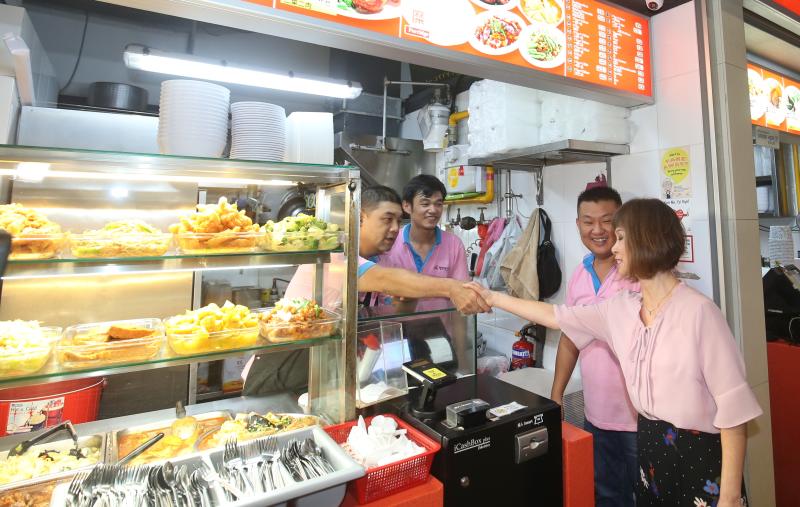'Social enterprise' management model for hawker centres may need fine-tuning: Amy Khor
Sign up now: Get ST's newsletters delivered to your inbox

Dr Amy Khor, Senior Minister of State for the Environment and Water Resources, at a site visit to Hawker Centre@Our Tampines Hub on Sept 7, 2018.
PHOTO: SHINMIN WANBAO
Joyce Lim, Joyce Lim
Follow topic:
SINGAPORE - The current alternative management model for hawker centres would have to be fine-tuned over time to achieve its social objectives, said Dr Amy Khor.
The Senior Minister of State for the Environment and Water Resources was responding to the issue of whether the next 13 hawker centres to be built by 2027 will adopt this alternative model.
The Government had introduced this model, better known as "not-for-profit social enterprise" three years ago, with the aim to keep food prices low and make the hawker trade sustainable.
Dr Khor, who was visiting the Hawker Centre@Our Tampines Hub on Friday (Sept 7), said: "We are evaluating and we will make tweaks to the models. We will then decide what will be an appropriate model when the next new hawker centre comes up.''
"One of the very key tender evaluation criteria that we have when we evaluate the bids that come in, is the rental and operating costs that managing agents will charge stallholders.
"Those that propose lower rentals and operating costs are the ones that will be considered more favourably. Indeed we are very mindful that we need to ensure that the hawkers can make a decent livelihood," she added.
Makansutra founder and food consultant KF Seetoh had taken issue with the new model and said it will be an uphill task to achieve those social objectives when hawkers struggle to pay high operating costs under privately run social enterprises.
In a recent post published on his website, Mr Seetoh flagged the additional costs hawkers have to pay on top of rent. Such costs add up and some hawkers are apparently paying $4,000 a month, which is double their monthly rent, to the private operators.
Mr Seetoh said he was shocked that hawkers are made to pay for coin-changing service, washing of crockery, collection and return of trays despite efforts and costs to facilitate self tray-return.
Currently, only seven out of 114 hawker centres are new centres managed by private social enterprises and cooperatives - Fei Siong Social Enterprise, NTUC Foodfare, Timbre+Hawkers, Hawker Management by Koufu and OTMH by Kopitiam.
Thirteen more hawker centres will be built by 2027.
As the alternative management model is still in its infancy stage, it is too early to tell if the next 13 hawker centres will be run under the same model.
Dr Khor said: "It is a constantly evolving process. What we are doing is always look at ways to better manage our hawker centres even as we also continue to look at ways to improve and upgrade our hawker centres in terms of physical structure and amenities... so I think we have to consider both the hardware and software."
She stressed that the managing agents are not allowed to increase rental or operating costs during the lease period.
But when asked if additional costs like advertising should be made optional to hawkers, Dr Khor said: "The fundamental areas are already inside the tender.
"We also need to give some leeway for innovation in order to again explore different ways to enhance the management model. So there may be some optional cost like coin exchange. These are optional, these are services that the managing agents may want to offer but they will inform us of such optional services."
Last month, Prime Minister Lee Hsien Loong said that Singapore will bid for a listing of its hawker culture on Unesco's list of intangible cultural heritage.

